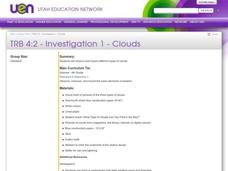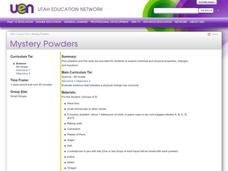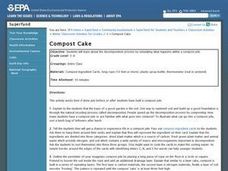Curated OER
What is Magnetism?
Learners investigate magnetism. In this physics lesson, students create a KWL chart about magnetism and research various suggested websites to find out more about magnetism. Learners log on to the "BrainPOP" website and view a short...
Curated OER
Particulate Matter
Seventh graders examine the different types of pollutants. In this environmental science lesson, 7th graders observe particulate matter under a microscope. They explain how these can affect once health when breathed in large quantities...
Curated OER
Developing Models
Students study the concept of a scientific model and demonstrate climate change models. In this scientific instructional activity students design a model using direct and indirect evidence and use it to make hypotheses.
Curated OER
Does Dye Die? Foreign Chemicals in Our Environment
Students conduct an experiment to observe photolysis in the lab. In this chemistry lesson, students explain the mechanism behind photolysis. They test the impact of a non-toxic marker to plant metabolism.
Curated OER
Clouds
Students observe and record different types of clouds. They use a cloud chart to discuss the three cloud types to see if students can identify the clouds they drew.
Curated OER
Mobius Strips
Students discuss the scientific method and construct their own Mobius Strips. They examine their Mobius Strip, and write observations and a hypothesis on how many strips of paper they have when they cut the strip in half length-wise.
Curated OER
Move It, Sir Isaac!
Third graders analyze the work of Sir Isaac Newton as they investigate the laws of motion and force. Inertia is observed through a lump of clay.
Curated OER
Mystery Powders
Fifth graders evaluate the physical properties of 5 powders. Each powder is subject to different conditions. They describe each observation as with a chemical change or a physical change.
Curated OER
Earthquakes
Fifth graders explore the causes of earthquakes and the various types of fault lines through a variety of hands-on demonstrations using prepared cakes. They record their observations in their science journals.
Curated OER
Compost Cake
Students examine the decomposition process. They create their own class compost pile and record their observations. They discover which materials decompose at a different rate.
Curated OER
Simple Rocket Science
Students demonstrate Newton's Third Law of Motion. They discuss the history of rockets, observe how a rocket works, and draw a picture and write an explanation of the balloon experiment.
Curated OER
More Rocket Science
Young scholars observe two rocket science experiments, and create a graph to demonstrate the results. They draw a picture and write an explanation of the results of the experiments.
Curated OER
environment: Fresh and Saltwater Habitats
Young scholars compare and contrast fresh and salt water coastal environments. After describing how sea animals adapt to their habitats, they design a variety of sea creatures and explain how the adaptations aid in the animals'...
Curated OER
Bulbs & Batteries in a Row
Students investigate simple series circuits and their properties. In small groups they draw a circuit diagram on their Series Circuit Building worksheet, follow step-by-step directions to construct a simple series circuit, and solve...
Curated OER
Tides & Lunar Cycles
Students demonstrate how the moon affects the tides, a neap tide, and spring tides by using their bodies as models. After students observe the model they created, they draw and label the diagram on a provided worksheet. They then log...
Curated OER
Sunny Sunflowers
First graders, after assessing how plants grow in relation to light, create models of sunflowers within a game to help them remember their science lesson. In addition, their visual models serve as a demonstration of photo tropism in...
Curated OER
Physics: Bounce - Projectile Motion and Collisions
Students conduct and observe experiments in Newtonian mechanics, kinematics, and projectile motion. They analyze the motion of a ball rolling off a table, falling, and then bouncing. Students answer a series of questions analyzing the...
Curated OER
Multiplication and Division Grouping
Fifth graders rotate through six math stations to solve a variety of story problems involving multiplication and division. They observe a demonstration of how to do multiplication and division using grouping, then solve the story...
Curated OER
Emotion Masks
Students analyze and discuss masks of different cultures as an art form to evoke emotion. This lesson culminates in the creation of individual mask designs and self-directed assessment (included).
Curated OER
Problem Solving Process: One-To-One Correspondence
First graders observe and demonstrate a variety of problem solving strategies to solve problems involving one-to-one correspondence and whole numbers to 100. They discuss the steps of the problem solving process, and solve a word...
Curated OER
Variables and Open Sentences
Fourth graders examine the purpose of variables and identify the missing variable in open sentences. They observe the teacher solve a variety of problems, complete a worksheet as a class, and independently complete another worksheet. ...
Curated OER
Properties of Multiplication
Fifth graders examine the process of multiplication and the relationship between addition and multiplication. They observe the teacher model a variety of problems on the board, and identify properties of multiplication. Students...
Curated OER
Mean, Median, and Mode
Seventh graders examine the uses of mean, median, and mode. They define key vocabulary terms, observe the teacher model examples of mean, median, and mode, and discuss real world examples of central tendency of sets of data. Students...
Curated OER
Fractions
Students observe and demonstrate a variety of activities to identify the fraction parts and the symbols they represent. As a class they explore different fractions using unifix cubes, then use the cubes to build and discuss the...
Other popular searches
- Euglena Direct Observation
- Eugenia Direct Observation
- Euglenda Direct Observation
- Glenda Direct Observation
- What Is Direct Observation

























